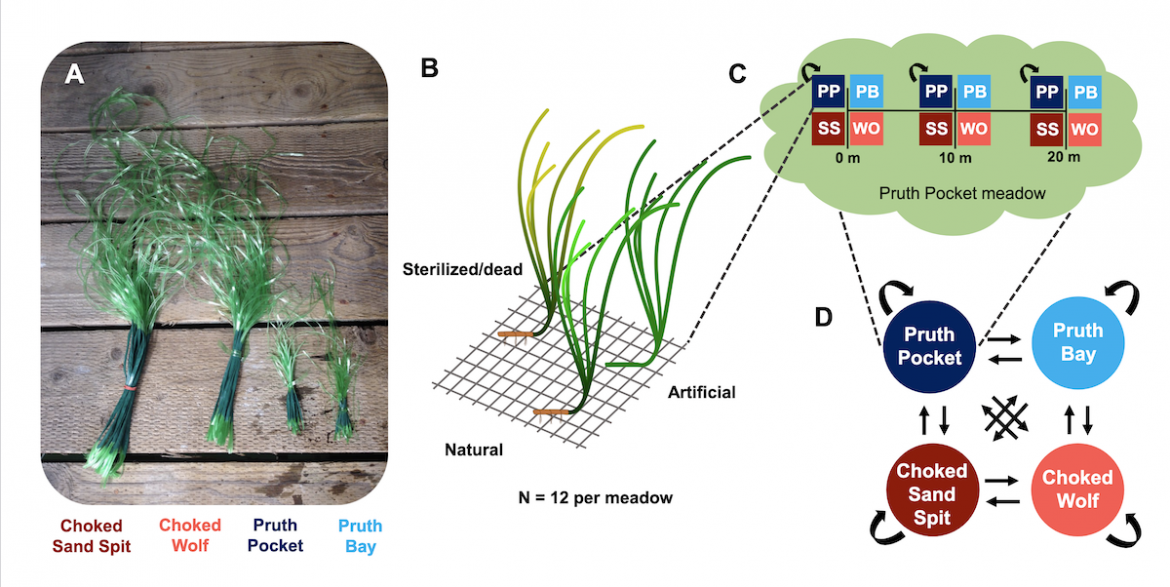
Figure 2.(A) Artificial seagrass shoots fabricated from 1 mm thic k polyethylene plastic (leaves) and dark green electrical tape (sheath). The different sizes represent the average seagrass shoot sizes from four different seagrass meadows (Table S3). The larger shoots are based off seagrass shoots from Choked Passage and the smaller shoots are based off seagrass shoots from Pruth Bay. (B) Experime nta l unit design. Each experime nta l unit contained one natural seagrass shoot, one sterilized/dead seagrass shoot, and one artificial seagrass shoot. We made 12 experimental units per meadow (48 total). (C) Exp e rime n ta l units were deployed into each of the four meadows, and each meadow contained 12 experimental units (48 total). We deployed three replicates of three units containing natural and sterilized/dead seagrass shoots transplanted from other meadows and an outplanted artificial seagrass shoot, and three replicates of one unit containing natural and sterilized/dead tissue shoots replanted from the original meadow and an o utp la nte d a rtific ia l seagrass shoot. Experimental units were installed at 0 m, 10 m, and 20 m along a 20 m transect line. PP = Pruth Pocket, PB = Pruth Bay, SS = Choked Sand Spit, WO = Choked Wolf. (D) Reciprocal transplant experiment design. Straight arrows indicate transplant lo c a tion between each meadow and curved arrows represent replant location to original meadow.
Originally posted August 12, 2021
Emily M. Adamczyk, Mary I. O’Connor, Laura Wegener Parfrey. 2022. Seagrass (Zostera marina) transplant experiment reveals core microbiota and resistance to environmental change. Molecular Ecology
Abstract
Zostera marina (seagrass) is a coastal marine angiosperm that sustains a diverse and productive ecosystem. Seagrass-associated microbiota support host health, yet the ecological processes that maintain biodiversity and stability of the seagrass leaf microbiota are poorly understood. We tested two hypotheses: (1) Microbes select seagrass leaves as habitat such that they consistently host distinct microbiota and/or core taxa in comparison to nearby substrates, and (2) seagrass leaf microbiota are stable once established and are resistant to change when transplanted to a novel environment. We reciprocally transplanted replicate seagrass shoots (natural and surface sterilized/dead tissue treatments) among four meadows with different environmental conditions and deployed artificial seagrass treatments in all four meadows. At the end of the 5-day experiment, the established microbiota on natural seagrass partially turned over to resemble microbial communities in the novel meadow, and all experimental treatments hosted distinct surface microbiota. We consistently found that natural and sterilized/dead seagrass hosted more methanol-utilizing bacteria compared to artificial seagrass and water, suggesting that seagrass core microbiota are shaped by taxa that metabolize seagrass exudates coupled with minor roles for host microbial defence and/or host-directed recruitment. We found evidence that the local environment strongly influenced the seagrass leaf microbiota in natural meadows and that transplant location explained more variation than experimental treatment. Transplanting resulted in high turnover and variability of the seagrass leaf microbiota, suggesting that it is flexibly assembled in a wide array of environmental conditions which may contribute to resilience of seagrass in future climate change scenarios.